Using STEM to Change the World
"Courage is being scared to death but saddling up anyway" - Shawn
STEM students and professionals are often motivated by the positive impact their work may have in the world. This includes people with disabilities in STEM The goal of AccessSTEM is to increase the number of individuals with disabilities completing postsecondary STEM degrees and entering the STEM workforce. AccessComputing has a similar goal, but focuses more narrowly on computing fields.
Project interventions for students with disabilities are consistent with the five conditions for nurturing healthy, successful children identified by America’s Promise—The Alliance for Youth: caring adults, safe places and constructive use of time, a healthy start and healthy development, effective education for developing marketable skills and lifelong learning, and opportunities to make a difference through helping others.
Through project activities, participants are encouraged to learn science (attraction), choose to keep learning mathematics and science (retention), graduate (persistence), and continue into STEM careers (attachment)—steps encouraged by the NSF Committee on Equal Opportunities in Science and Engineering.
Additionally, project leaders are guided by the results of an evaluation of research about NSF-funded programs conducted by SRI International in 2009 in which AccessSTEM was featured. SRI International identified important characteristics that contributed to successful outcomes of AccessSTEM were interventions that promote
- Belonging (both academic & social integration),
- Involvement (in academic & social life),
- Purpose (e.g., through internships, workshops, networking, mentoring), and
- Self-determination (skill building, practice).
Some students are excited about working on assistive technology, software, applications, health care, and other products designed to help individuals with disabilities. Others are more interested in using their STEM degree to work on myriad pressing issues such as climate change, national defense, social inequities, national infrastructure, and public policy.
In the following section of this book, students share their ideas about using STEM to change the world around them.
“Education is by far the most powerful weapon you can use to change the world.” - Nelson Mandela
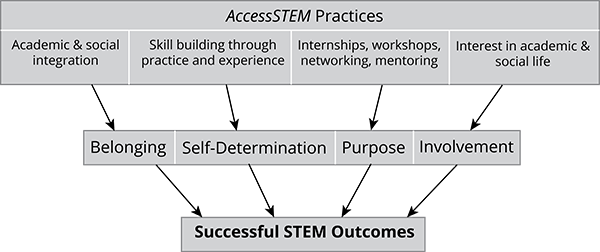
Erika
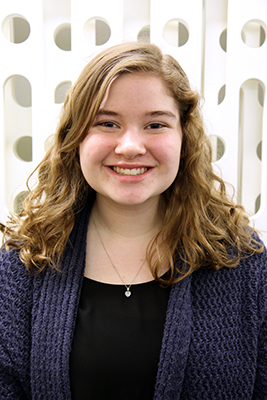
Assistive Technology
I think a lot about how people view my disability and that has always been part of the reason I want to pursue a STEM career. My experiences have led me to believe that few people have the expectation that deaf people will pursue or succeed in STEM.
I have always tried to prove that I can do anything I set my mind to. I graduated from high school with numerous awards. This included being the first deaf speaker at graduation and being in the “Principal Hall of Fame.” All of these awards reflect my dedication and focus in high school and helped me get into the University of Washington. I hope my accomplishments make me a role model and show other deaf people that disability shouldn’t limit one’s success in life.
From a young age, my parents encouraged me to overcome the challenges related to my disability. Through a college-preparation program, I learned skills to advocate and stand up for myself and not let my disability define my path to success. AccessComputing’s Summer Academy for Advancing Deaf and Hard of Hearing in Computing helped me explore numerous STEM careers through networking with people locally and nationally. This helped me build connections and gave me basic tools to get started on a career in computer science.
I intended to study biomedical engineering before changing to computer science, following a newfound passion for programming. I know that computing will offer me the challenges I’m looking for while pursuing my dream to design assistive technology and create prototypes that will change how people with disabilities access the world around them. I don’t want people with disabilities to feel they cannot follow their passions based on what other people say or their own doubts.
In my vision for the future, I see people with disabilities doing the previously perceived impossible and having just as many career opportunities as able-bodied people. I also dream of seeing more people with disabilities in STEM fields and showing what people can accomplish with perseverance and determination.
Tiyah
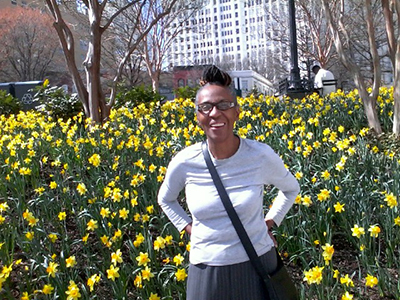
Technology & Independence
One of my greatest passions is using technology to engage older individuals with a disability towards discovery and independence, especially in the digital world. I have worked hard to grow a toolbox of skills, including going back to school to receive a B.S. in vocational technical education with an emphasis on computer instruction and a certificate in library information science technology. Both of these accomplishments have been a huge asset in helping others and making my dream a reality.
In the 70’s I received training on personal computers. I fell in love with computers and way they can empower people. I used these skills while working as a technical support specialist and in the hospital field, where I facilitated computer productivity trainings and set up databases.
Eight years later, I developed carpal tunnel syndrome that morphed into severe rheumatoid arthritis, which challenged my professional and personal ambitions. I had suffered great loss of hand functionality because of acute deformity. Eventually, my injury caused me to lose my job and lose hope about mastering computing skills. Medically, I couldn’t return to operating computers the way I had done before. I worried that my dreams and ideas in the technical world were at an end.
Then one day, I was volunteering at a science museum and I discovered accessible technology! Various products such as Dragon Naturally Speaking were being exhibited
and demonstrated. This experience helped me find the courage to redefine my life and enter back into the computing world. I decided to “take my life by the horns.” This is when I decided to go back to school and use my passion for technology in a different way. Between vocational rehabilitation, my family, and a progressive school disability services, I was successful.
For the next ten years, I went on to run computer labs, work at Intel, and be an accessibility technology assistant. I mentor students with disabilities to succeed in STEM. My toolbox of skills will help me achieve anything I set my mind to, and with my recent certification, I plan on following my passion of helping individuals find independence through technology.
Brandon
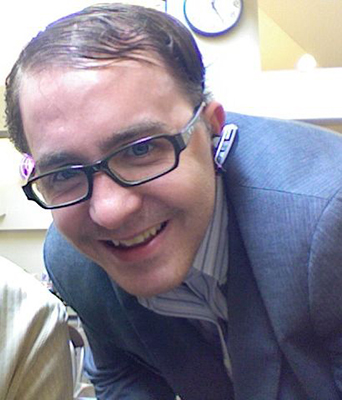
Education
Ever since I was in kindergarten, I’ve wanted to be a teacher. I have always been a lover of science, knowledge, and helping others. Throughout my life, I have had the privilege of great teachers who showed me the meaning and value of education, and I hope to share that with future students. My big idea is to change the educational system so no one feels isolated or cut off from education, which will help students with disabilities be more accepted and valued and hope for a brighter future.
When I was thirteen, I sustained a traumatic brain injury that turned my life upside down. I started to have a profoundly negative experience throughout high school by being isolated from my peers. I questioned whether I still wanted to be a teacher and what options I even had with my new disability. Eventually, I decided I still wanted to be a teacher. In college, I had the opportunity to reflect on my high school experience and my future aspirations and realized, although I did still want to be a teacher, I was meant to help make the world better for people with disabilities. I changed majors to psychology to better understand the human mind and decided to go to graduate school to become a counselor. My passion became helping adolescents with disabilities have fulfilling and meaningful school experiences.
I have now been trained as a teacher and a psychologist as well as a mental health and vocational counselor. I’ve also had training as an assistive technology specialist and utilize a right-handed keyboard on which I can type upwards of 70 words per minute. My right-handed keyboarding ability aided me greatly throughout school, making it possible for me to type long papers.
Through education, living as a person with a disability, and observations of social constructs, I have a perspective on disability, community, and society that will assist me in making contributions to the disability community. At my current job, I help people with disabilities get into the workforce, but I endeavor to become a licensed mental health counselor with strong technical skills.
Alysa
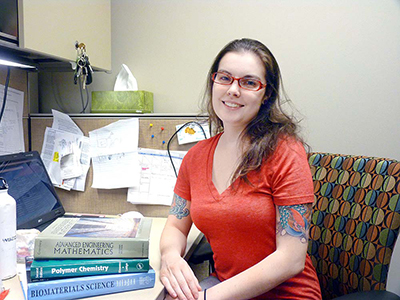
Engineering
My big idea is in cardiac tissue engineering, where I am focusing on the properties of the polymer scaffolds that will drive the differentiation of induced stem cells into human heart tissue.
When I was young, I spent all of my time reading about science and technology, looking for bugs in my backyard or doing science experiments in the kitchen. I was the first person in my family to attend college, and I originally graduated with a degree in psychology. After a few years, I realized I wanted to go back to study chemical engineering.
I decided to follow my passion for research because I’m a hands-on person. A friend of mine had gone back to school for engineering and told me about her new job doing fieldwork. I felt jealous, but then I realized there was no reason I couldn’t be an engineer like her. Though I was working as IT support for Microsoft at the time, when my contract ended I decided to return to school to study chemical engineering.
I had health problems that became disabilities by the time I started class—chronic pain that made it difficult for me to concentrate, and, when I got sick, I had to stay in bed for several days. Returning to school with disabilities
was a challenge, but I’ve had so much support that my health problems haven’t held me back. I took prerequisite courses at Bellevue College, where they introduced me to AccessSTEM, a project that continued to provide encouragement and success strategies as I transferred to the University of Washington. While at University of Washington, I was involved in student leadership, did multiple research projects, and completed a year-long internship.
With the encouragement of my professors, I applied for graduate programs, and I decided to attend the University of Texas at Austin. Although it’s been difficult, I am incredibly excited about the chance to contribute to science and technology. After earning my Ph.D., I will continue working in research, possibly becoming a professor.
Ivan
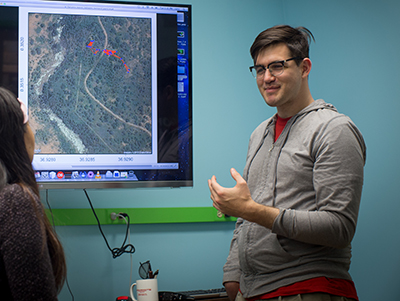
Data Mining & Research
I am a computer science Ph.D. student at the University of Illinois at Chicago, in the computational population biology lab. In my research, I develop data mining and machine learning methods for prediction in networks. I focus on interdisciplinary computational sciences, including ecology, biology, and atmospheric science. Science has always been a passion of mine; interdisciplinary research has allowed me to gain familiarity with several areas of science from a computational perspective, and I have produced work that would not be possible without close collaboration.
As a person living with cerebral palsy, I am active in advocacy and inclusion within computer science for women and other underrepresented groups. I am a 2014 Google Lime Scholar, and I volunteer with the Broadening Participation in Data Mining workshop. In my youth, I lacked the peer support I’ve now gained through these activities. At that time, I had lowered expectations for my career path and discomfort in my own body. I want to ensure that young students have the support and encouragement to succeed in research.
In a crowded professional field, I see my disability as a slight but valuable distinction and an opportunity to be a positive representation to colleagues who may not know others with cerebral palsy. By making connections and proactively sharing research ideas, I have gained research-oriented internships at Technicolor Research, Lawrence Livermore National Laboratory, and Microsoft. Furthermore, I have gained a strong intellectual connection to data mining and machine learning. I aim to contribute to these areas throughout my career.
I feel that interdisciplinary computational science dramatically extends the capability of scientific investigation. Combining deep scientific knowledge with statistics and computational methods allows scientists to develop novel hypotheses on data too large and complex to directly visualize and understand. In my research, I develop computational methods that extract repeatable and significant patterns in complex data, while scientists investigate why these patterns emerge.
I wish to see more top minds in data mining and machine learning dedicated to creating novel scientific and algorithmic understanding. Many of the grand open questions in science are now data-driven questions: how does consciousness emerge from biological structure? Does life exist elsewhere in the universe? Aside from these grand visions, new and more sophisticated data are opening up several scientific disciplines to new opportunities for interdisciplinary research. I am tremendously excited to enter such a vibrant and expanding landscape of data-driven science. I have big ideas about how data-driven science can change the world.
Shawn
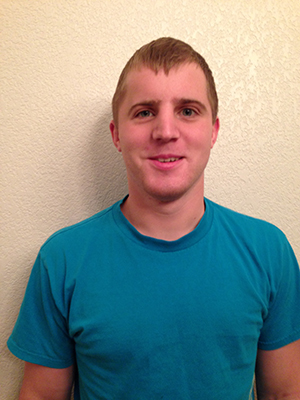
Mechanical Engineering
I became interested in engineering while in high school because math and physics came easily to me, and I had an interest in automobiles. Since I couldn’t be a professional racecar driver due to my visual impairment, I decided to study what made cars, trucks, planes, and other mechanical objects work. I have big ideas for new and improved vehicle designs!
I am currently pursuing a bachelor’s degree in mechanical engineering, along with minors in business, mathematics, and aerospace engineering, at Embry-Riddle Aeronautical University in Prescott, Arizona. I decided to attend Embry- Riddle Aeronautical University to study mechanical engineering because they have an outstanding reputation for their aerospace program. They have also never had
a blind student attend their university before. I wanted to take the road less traveled, pave the way for others to come, and become more independent by getting out of my comfort zone.
Though I struggled at first with available resources, Embry-Riddle’s disability services center worked hard to provide me with the tools I needed to succeed. My professors, my advisor, and I worked together to make sure all of my classes were accessible, and the Washington State Services for the Blind assisted me in tuition costs and accessible equipment. My family has also supported me and helped obtain materials to assist me in my everyday endeavors.
My goal is to become an engineer in the automotive industry. I want to use STEM to design new vehicles— ones that are safer, more efficient, and more reliable. In order to achieve that success, I will continue to take on tasks with everything I have. One of my favorite quotes is “courage is being scared to death, but saddling up anyway.” I will continue to utilize all support and services available to me in my quest to achieve my goals. Success and happiness is what you make of it, and only you can decide whether you will be at the top of the mountain or at the rock bottom.
Johanna
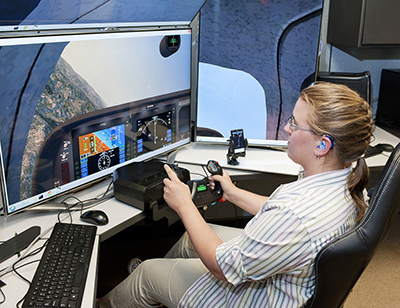
Human-Centered Engineering
My high school didn’t have computer science classes; I had no exposure to computer science until I was 16 years old. That year, I was accepted AccessComputing’s Summer Academy for Advancing Deaf and Hard of Hearing in Computing, a nine-week program at University of Washington. When I learned about HTML and JavaScript, it was like a brand new world to me. I loved the puzzle of figuring it out and realized that computer science was a good match for me. I was invited back as a teaching assistant for the Summer Academy the following summer, where I learned about Java. It was amazing experience overall. I continued studying computer science when I enrolled at the University of Minnesota.
I use American Sign Language (ASL) interpreters in order to access my classes. Since ASL is my native language, when I’m reading English during an exam, I need an interpreter to translate it to ASL to fully understand the instruction and questions. Professors have been open to my questions and comments and have gladly accepted my feedback regarding lecture style (consider using a laser pointer to point to specific material on PowerPoint slides), usage of board (better organization), and tips on working with interpreters (look at me instead of the interpreter and speak at a normal pace).
This past summer, I had the honor of participating in a 10-week summer internship with NASA’s Dryden Flight Research Center in California. Through the internship, I developed new and improved partially developed graphic elements and human interaction aspects of an Android application. The app is a collision avoidance technology that provides warning cues to pilots when they are too close to or are about to collide with terrain. The people I worked with were wonderful with communication. I used a combination of ASL, speech, and Ubuntu when I had causal one-on-one meetings with a person. For group and formal meetings, I mainly used an ASL interpreter. At one point, I asked my support specialist for a keyboard tray. Another time, I needed more information about Android Development Tools, and my coworkers lent me books to use over the course of the internship.
The experience of working on an app during my internship further fueled my passion for human and computer interaction and my desire to improve individuals’ standard of living through technology. I ultimately want to develop and improve technology in terms of usability, accessibility, and quality through apps, and I hope to work in a team-oriented environment. I want to grow as a leader in my profession.
Claudia
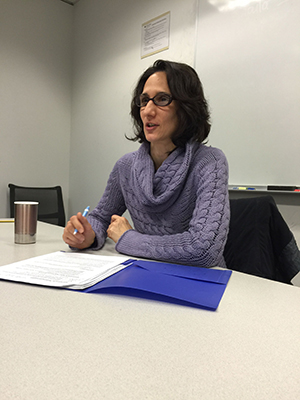
Environment & Community
Usually summers and holidays are filled with dread as most of my more able- bodied friends go off and travel, and I am stuck at home without much to do. However, this last summer, I did a variety of things to help me organize my academic plan for the coming years. A small stroke of luck, in the form of a meandering snail, made all the difference.
Going back to school took an enormous amount of courage given my disability. Luckily, as I adapt to my physical condition, more and more I find myself being myself, which is reassuring. This might sound like common sense, but it’s much harder to do than people may realize, especially when dealing with a body that often has a mind of its own.
Recently, I participated in an accessibility review event at our local aquarium to comment on the facility and whether people with disabilities can access the experience. It was busy that day, and usually I avoid crowded areas and large groups, because I know that most of the experience will end up being inaccessible to me. In spite of being used to barriers, this event got me thinking about what it could be like to have equal access and fully experience facilities like the aquarium.
While I was still pondering the aquarium accessibility review, I participated in another event volunteering on a campus-affiliated farm. I found it difficult to volunteer given my physical limitations. There were several things I couldn’t do. I was frustrated, but I thought about this event and the aquarium accessibility review, and it inspired deeper thinking about community and environment.
I was struggling to make progress, but then a lucky thing happened. I was at a public school waiting for my child, and a snail crawled across a patch of newly cleared ground between the school’s garden beds. As I was taking a picture of the snail, the person who built the beds walked up and introduced himself. We ended up talking for a while, and I learned that he teaches biology on my university campus! He built the beds in order to get people involved with nature and excited about biology.
Through that interaction, I realized I’d like to bring together my majors (environmental science resource management and community and environmental planning) by starting a project between the campus farm and the public schools, with an emphasis on integrated community access and participation. I never expected to come up with anything like this at the start of summer. I drafted a plan for my project and hope to implement my ideas and count it as part of my degree requirements. I think I have a great idea for using my STEM education, and I’m excited to bring it to life.